DJI
SZ DJI Technology Co., Ltd.[3] or Shenzhen DJI Sciences and Technologies Ltd. (Chinese: 深圳大疆创新科技有限公司) in full,[4] more popularly known as its trade name DJI which stands for Dà-Jiāng Innovations (Chinese: 大疆创新, "great frontier innovation"), is a Chinese technology company headquartered in Shenzhen, Guangdong with factories throughout the world. DJI is a world-leading manufacturer of commercial unmanned aerial vehicles (commonly known as "drones") for aerial photography and videography. It also designs and manufactures camera gimbals, action cameras, camera stabilizers, flight platforms and propulsion systems and flight control systems.
 | |
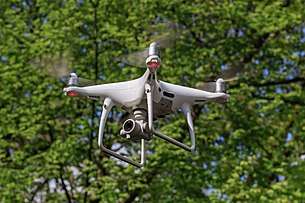 DJI Phantom 4 Pro | |
| DJI | |
Native name | 大疆创新科技有限公司 |
| Private | |
| Industry | |
| Founded | 2006 |
| Founder | Frank Wang (Wāng Tāo) |
| Headquarters | , |
Area served | Worldwide |
| Products |
|
| Revenue | |
Number of employees | 14000[2] (2018) |
| Divisions |
|
| Subsidiaries | Hasselblad |
| Website | www |
DJI is the dominant market leader in the civilian drone industry, accounting for over 70 percent of the world's drone market.[5] Its camera drone technology has been used widely for the music, television and film industries. The company's products have also been used by militaries and police forces,[6] as well as terrorist groups, with the company taking steps to limit access to the latter.[7] US government institutions have issued statements discouraging their internal use of DJI products,[8] but as of 2020, various agencies at the local and federal level continue to use DJI products.[9]
History

The company was founded in 2006 by Frank Wang (Wāng Tāo, 汪滔).[10] Wang, who went to Hong Kong in 2003 after enrolling for a degree course in Hong Kong University of Science and Technology (HKUST). He was part of the HKUST team participating in ABU Robocon and won third prize.[11]
Wang built the first prototypes of DJI's projects in his dorm room, selling the flight control components to universities and Chinese electric companies. He used the proceeds to move to the industrial hub of Shenzhen and hired a small number of staff in 2006. The company struggled at first, with a high degree of churn among employees that has been attributed to Wang's abrasive personality and perfectionist expectations of his employees. The company sold a modest amount of components during this period, relying as well on financial support from Wang's family friend, Lu Di, who provided USD $90,000 and managed the company's finances.[12] In 2009, DJI's components allowed a team to successfully pilot a drone around the peak of Mt. Everest.[9]
In 2010, Wang hired a high school friend, Swift Xie Jia, to run the company's marketing. DJI began to cater more to drone hobbyists in markets outside of China. In 2011, Wang met Colin Guinn at a trade show, and the two of them founded DJI North America, a subsidiary company focusing on mass market drone sales. In 2013, DJI released the first model of the Phantom drone, an entry-level drone which was significantly more user-friendly than any other drone on the market at the time. The Phantom was a worldwide commercial success, but this success led to conflict between Guinn and Wang. Midway through the year, Wang made an offer to buy Guinn out, which Guinn refused. By the end of the year, DJI had locked all employees of the North American subsidiary out of their email accounts and was well on its way to shutting down the subsidiary's operations. Guinn sued DJI, and the case was settled out of court.[12]
In 2015, DJI eclipsed the success of the Phantom with the release of the Phantom 3, whose even greater popularity was in part due to the addition of a built in live-streaming camera.[9] DJI was now the largest consumer drone company in the world,[13] driving many of its competitors out of the market over the following years.[9] 2015 also marked the beginning of DJI's RoboMaster Robotics Competition (Chinese: 机甲大师赛), an annual international collegiate robot combat tournament held at the Shenzhen Bay Sports Centre.[14]
In 2017, DJI won a Technology & Engineering Emmy Award for its camera drone technology, which was used in the filming of various television shows including The Amazing Race, American Ninja Warrior, Better Call Saul and Game of Thrones.[15] That same year, Wang became Asia's youngest tech billionaire.[16]
2017 was also the year that DJI announced a plan to provide surveillance drones for use by the Chinese police in Xinjiang.[9] In August, the United States Army published internal guidance banning the use of DJI products for security reasons, although as of 2019 other branches of the US military continue to use its products in a limited capacity.[8] On 17 November 2017, Ars Technica reported a security breach of private customer data at DJI.[17] The company denied the existence of such a breach, and subsequently added an offline mode that allows its drones to fly without transferring data over the internet.[18]
On 5 June 2018, police body cam and Taser maker Axon announced a partnership with DJI to sell surveillance drones to U.S. police departments.[19][20] As of 2020, DJI products are also widely used by American police and fire departments.[9]
On 21 January 2019, DJI announced that an internal probe had uncovered "extensive" fraud by certain employees who "inflated the costs of parts and materials for certain products for personal financial gain."[21] DJI estimated the cost of the fraud at "up to RMB 1 billion" (US$147 million), but maintained that the company "did not incur a full year loss in 2018."[22]
In January 2020, the United States Department of the Interior announced that it would be grounding around 800 drones, which it had been using for wildlife conservation and infrastructure monitoring purposes. As of March 2020, DJI holds nearly 77% of the US market share for consumer drones, with no other company holding more than 4%.[9]
Incidents involving DJI products
In January 2015, a Phantom 3 crashed into the White House's south lawn, in Washington, D.C., US.[23] DJI later set up a no-fly Geo-system according to prohibited airspace, and forced all drones to update the firmware. The new system will forbid flights getting closer or take off in restricted zones based on its GPS location.[24]
In 2016, ISIS used DJI drones as exploding devices in Iraq.[25][26] DJI later created a broad no-fly zone over nearly all of Iraq and Syria.[7] That year, a DJI drone was nearly involved in a midair collision with a Chinese fighter jet. The Chinese government subsequently insisted that DJI develop an air traffic registry to track its drones within China.[9]
On 30 March 2018, Israel Defense Forces used DJI’s Matrice 600 drone to drop tear gas from above caused injuries, panic and death during Gaza and West Bank protests.[27][28]
On 4 August 2018, two Matrice 600 drones detonated explosives near Avenida Bolívar, Caracas in an apparent attempt to assassinate Nicolás Maduro.[29]
Company infrastructure
DJI is known for having a very difficult hiring process, as well as an extremely competitive internal culture. Teams are often pitted against each other to design better products.[9]
DJI's factories in Shenzhen include highly sophisticated automated assembly lines, including portions where drones under construction "take off on their own by the hundreds, performing a series of maneuvers over the course of two minutes, then land and continue moving down the manufacturing line". Many of the components for these assembly lines are built in-house.[9]
Products
Flight systems
Controllers
DJI develops flight controllers intended for multi-rotor stabilization control of various platforms or heavy payloads in aerial photography. The A2 controller includes orientation, landing, and home return features. Products include GPS-compass receivers, LED indicators and Bluetooth connectivity.[30][31]
| Model | A2 | Naza V2 | Wookong-M | Naza-M Lite |
|---|---|---|---|---|
| Number of motors supported | 4–8 | 4–8 | 4–8 | 4–6 |
| Has built-in receiver | yes (2.4 GHz) | no | no | no |
| Hovering accuracy (m) | vertical: ±0.5m / horizontal: ±1.5m | vertical: ±0.8m / horizontal: ±2.5m | vertical: ±0.5m / horizontal: ±2m | vertical: ±0.8m / horizontal: ±2.5m |
| Motor-rotor configuration | quad-rotor: +4,X4; hex-rotor: +6,X6,Y6,Rev Y6; octo-rotor: +8,X8,V8 | quad-rotor: I4, X4; hex-rotor: I6, X6, IY6, Y6; octo-rotor: I8,V8,X8 | quad-rotor: +4,X4; hex-rotor: +6,X6,Y6,Rev Y6; octo-rotor: +8,X8,V8 | quad-rotor I4, X4; hex-rotor I6, X6, IY6, Y6 |
Gimbals, camera stabilization, platforms
Ronin
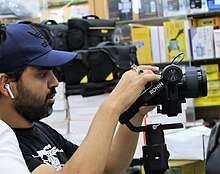
The Ronin (如影) is a standalone ground-based camera platform developed for cinematography and aerial filmmaking in professional environments. It is built for professional videography and photography and targets the film industry. By using three individual motors, Ronin stabilizes when moving vigorously.[32] Later models of the Ronin include the Ronin-M, Ronin 2, Ronin-S, and Ronin-SC
Ronin-S
The Ronin-S is a single-handed form factor 3-axis gimbal designed for use with mirrorless and DSLR cameras up to 3.6 kg in weight.[33]
Ronin-SC
The Ronin-SC, launched on 17 July 2019, is an even lighter version of the Ronin-S gimbal. It has a similar battery life but is 41% lighter than the original. The Ronin-SC is designed to take mirrorless cameras that have a small form factor.[34]
Modules
DJI offers several add-on modules for their base products such as power management and video modules.
| Module | Lightbridge | PMU (A2, Wookong, Naza V2, Naza Lite) | iOSD MARK II | iOSD mini | BTU |
|---|---|---|---|---|---|
| Type (Purpose) | Video Downlink | Power Management | On-Screen Display | On-Screen Display | Bluetooth Link |
| Works With | A2, Wookong-M, Naza V2 | A2, Wookong-M, Naza V2, Naza-M Lite | A2, Wookong-M, Naza V2 | A2, Wookong-M, Naza V2 | Naza V2 |
| Interface | CAN Bus | CAN Bus, Battery Connection | CAN Bus | CAN Bus | CAN Bus |
| Battery Requirements | 4S-6S Lipo | 4S-12S Lipo | 4S Lipo and Shared Flight Controller Power | 2S Lipo and Shared Flight Controller Power | Shared Flight Controller Power |
UAVs
Flame Wheel
The Flame Wheel (风火轮) series are multirotor platforms for aerial photography. As of 2016, there is the hexacopter F550, and quadcopters F330 and F450. The most recent is the ARF KIT.[35][36]
| Model | Flame Wheel F330 | Flame Wheel F450 | Flame Wheel F550 |
|---|---|---|---|
| Diagonal wheelbase (cm) | 33 | 45 | 69 |
| Frame weight (g) | 156 | 282 | 478 |
| Take-off weight (g) | 600–1200 | 800–1600 | 1200–2400 |
Phantom
.jpg)
The Phantom (精灵) series are currently the most popular product, and since launch, have evolved to integrated flight programming with a camera, Wi-Fi or Lightbridge connectivity, and the pilot's mobile device.[37] Phantoms are made for aerial cinematography and photography applications,[38] but are also used in recreational use.[39]
There have now been four generations of the product line, each increasingly more capable.[40][41] The most recent one is the Phantom 4 RTK, announced on October 15, 2018.[42]
| Model | Phantom 1 | Phantom 2 | Phantom 2 Vision | Phantom 2 Vision+ | Phantom FC40 | Phantom 3 Standard | Phantom 3 4K | Phantom 3 Advanced | Phantom 3 Professional | Phantom 3 SE | Phantom 4 | Phantom 4 Pro | Phantom 4 Advanced | Phantom 4 Pro v2.0 |
|---|---|---|---|---|---|---|---|---|---|---|---|---|---|---|
| Diagonal wheelbase (mm) | 350 | 350 | 350 | 350 | 350 | 350 | 350 | 350 | 350 | 350 | 350 | 350 | 350 | 350 |
| Height (m) | 0.19 | 0.19 | 0.19 | 0.19 | 0.19 | 0.19 | 0.19 | 0.19 | 0.19 | 0.19 | 0.19 | 0.19 | 0.19 | 0.19 |
| Power consumption (W) | 3.12 | — | — | — | 3.12 | — | — | — | — | — | — | — | — | — |
| Take-off weight (g) | < 1200 | < 1300 | 1180 | 1284 | 1200 | 1216 | 1280 | 1280 | 1280 | 1280 | 1380 | 1388 | 1368 | 1375 |
| Max speed (m/s) | 10 | 15 | 15 | 15 | 10 | 16 | 16 | 16 | 16 | 16 | 20 | 20 | 20 | 20 |
| Endurance (min) | — | 25 | 25 | 25 | 10 | 25 | 25 | 23 | 23 | 25 | 28 | 30 | 30 | 30 |
| Rate of climb/descend (m/s) | 6 | 6/2 | 6/2 | 6/2 | 6 | 5/3 | 5/3 | 5/3 | 5/3 | 5/3 | 6/4 | 6/4 | 6/4 | 6/4 |
| Operating temperature (°C) | −10 to 50 | −10 to 50 | — | — | −10 to 50 | 0 to 40 | 0 to 40 | 0 to 40 | 0 to 40 | 0 to 40 | 0 to 40 | 0 to 40 | 0 to 40 | 0 to 40 |
| Maximum altitude (m) | 6000 | 6000 | 6000 | 6000 | 6000 | 6000 | 6000 | 6000 | 6000 | |||||
| Maximum range (m) | 1000 | 4000 | 5000 | 7000 | 7000 | 7000 |
Mavic
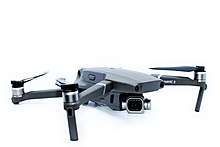
The Mavic (御) series currently includes Mavic Pro, Mavic Pro Platinum, Mavic Air, Mavic Air 2, Mavic 2 Pro, Mavic 2 Zoom, and the smallest, lightest, and cheapest DJI drone product, the Mavic Mini. Mavic 2 is one of DJI's flagship consumer drone, released on August 23, 2018. All have a foldable design that allow drones to be transported more easily.
The Mavic 2 features 360 degrees redundant sensors and obstacle avoidance to help prevent crashes.
| Model | Mavic Pro | Mavic Air | Mavic 2 Pro | Mavic 2 Zoom | Mavic Mini | Mavic Air 2 |
|---|---|---|---|---|---|---|
| Maximum Speed (Sport mode, no wind) | 40 MPH / 65 km/h / 18.0 m/s | 42.5 MPH / 68.4 km/h / 19.0 m/s | 45 MPH / 72 km/h / 20 m/s | 45 MPH / 72 km/h / 20 m/s | 29 MPH/ 46.8 km/h / 13 m/s | 42.5 MPH/ 68.4 km/h / 19 m/s |
| Maximum Speed (P-Mode) | 22 MPH / 35 km/h / 9.7 m/s | 15.5 MPH / 25 km/h / 6.9 m/s | 30 MPH / 48 km/h / 13.4 m/s | 30 MPH / 48 km/h / 13.4 m/s | 17.9 MPH / 28.8 km/h / 8 m/s | 26.84 MPH / 43.2 km/h / 12 m/s |
| Maximum Speed (WiFi only mode) | 8.7 MPH / 14 km/h / 3.9 m/s | -- | -- | -- | 8.9 MPH / 14.4 km/h / 4 m/s | |
| Empty weight (grams) | 734 (without gimbal cover) / 743 (with gimbal cover) | 430 (without gimbal cover) | 907 (max takeoff weight) | 905 (max takeoff weight) | 249 (default) / 199 (Japan) | 570 (max takeoff weight) |
| Flight time | ~27 Mins | ~21 Mins | ~31 Mins | ~31 Mins | ~30 Mins | ~34 Mins |
| Realistic flight time | ~21 Mins | ~16 Mins | ~29 Mins | ~29 Mins | ~27 Mins | ~27 Mins |
| Operating temperature (°C) | 32° to 104 °F (0° to 40 °C) | 32° to 104 °F (0° to 40 °C) | 14° to 104 °F (-10° to 40 °C) | 14° to 104 °F (-10° to 40 °C) | 32° to 104 °F (0° to 40 °C) | 14° to 104 °F (-10° to 40 °C) |
| Range (with controller) | 4.3 miles / 7 km, 2.2 miles / 3.5 km with CE controller. | 4 kilometers, 2 kilometers with CE controller | 5 miles / 8 km | 5 miles / 8 km | 4 kilometers, 2 kilometers with CE controller | 10 kilometers, 6 kilometers with CE controller |
| Range (with WiFi only) | 262 feet/ 80 meters | -- | -- | -- | -- |
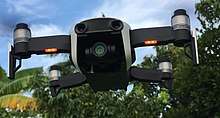
The Mavic Air was announced on 23 January 2018, for release on 28 January. It is marketed as a smartphone-sized drone that can fit in a jacket pocket.
It features a 12 MP 4K HDR camera, mounted on a 3-axis gimbal, and has a new panorama mode, which stitches together 25 photos in eight seconds to create a "Sphere Panorama". Due to antennas mounted on its landing gear, the drone has a 21-minute flight time and a 2.5 mile range. Like the Spark, the Air also features the "Smart Capture" mode, in which the drone can be controlled by hand gestures.[43]
The release of the Mavic Air 2 was not without controversy, however, as DJI announced that a key safety feature, AirSense (ADS-B), would not be available on models outside the USA[44]. Shortages on components and complexities of production owing to the ongoing COVID-19 crisis at the time were blamed.
Spreading Wings

The Spreading Wings (筋斗云) series are mainly industrial UAVs for professional aerial photography, high definition 3D mapping, ultra light search and rescue, and surveillance etc. based on camera gear on board. In 2013, two models have been released: S800 regular and EVO.[45]
| Model | Spreading Wings S800 | Spreading Wings S800 EVO | Spreading Wings S900 | Spreading Wings S1000 |
|---|---|---|---|---|
| Diagonal wheelbase (cm) | 80 | 80 | 90 | 104.5 |
| Empty weight (kg) | 2.6 | 3.7 | 3.3 | 4.2 |
| Take-off weight (kg) | 5 – 7 | 6 – 8 | 4.7 – 8.2 | 6 – 11 |
| Endurance (min) | 16 | 20 | 18 | 15 |
| Operating temperature (°C) | — | — | - 10 to 40 | - 10 to 40 |
Inspire
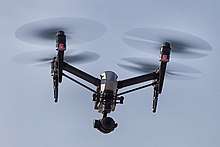
The Inspire (悟) series is a professional series of camera quadcopters similar to the Phantom line, but including more high-end and professional features including an aluminum-magnesium body with carbon fibre arms, and detachable props on the Inspire 2. Presented in 2017, the Inspire 2 can be equipped with a 6K camera that is capable of capturing up to 30 FPS.[46] Or a 4K camera that is capable of capturing 120fps as slow motion.
Inspire Specifications [47]
| Model | Inspire 1 | Inspire 1 Pro | Inspire 2[48] |
|---|---|---|---|
| Weight | 2935 g (Battery included) | 3400 g (Battery, propellers and Zenmuse X5 included) | 3440 g (Battery, propellers and camera on-board) |
| Takeoff weight | 3400 g | 3500 g | 4000 g |
| Hovering accuracy
GPS mode |
vertical: 0.5 m; horizontal: 2.5 m | vertical: 0.5 m; horizontal: 2.5 m | vertical: 0.5 m; horizontal: 1.5 m |
| Max angular velocity | pitch: 300°/s; yaw: 150°/s | pitch: 300°/s; yaw: 150°/s | pitch: 300°/s; yaw: 150°/s |
| Max tilt angle | 35° | 35° | 35° |
| Max ascent/descent speed | 5/4 m/s | 5/4 m/s | 5/6 m/s |
| Max speed | 22 m/s (ATTI mode, no wind) | 18 m/s (ATTI mode, no wind) | 24 m/s (ATTI mode, no wind) |
| Max flight altitude | 4500 m | 4500 m | 4500 m |
| Max wind speed resistance | 10 m/s | 10 m/s | 10 m/s |
| Operating temperature range | −10°−40 °C | −10°−40 °C | −20°−40 °C |
| Max flight time | approximately 18 minutes | approximately 15 minutes | approximately 27 minutes |
| Indoor hovering | Enabled by default | Enabled by default | Enabled by default |
| Release date | November 13, 2014 | January 5, 2016 | November 16, 2016 |
Matrice

The Matrice (经纬) series are designed for industrial applications.
The Matrice 600pro released November 2016, is an industrial drone that inherits everything from the M600 with the addition of improved flight performance and better loading capacity. The M600 now comes with pre-installed arms and antennas to help reduce the setup time. This is perhaps the biggest improvement over the older M600. With a maximum payload of 6 kg the Matrice 600pro can carry all types of payloads including LiDAR.
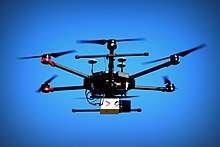
The Matrice 100 is a fully programmable and customizable drone, launched on July 6, 2015.[49] It has expansion bay and communication ports, which allows developers to add additional components for different purposes. [50]
Matrice 200 series is a range of weatherproof quadcopters from DJI announced in February 2017.
They are designed for industrial applications, including surveying, inspection, search and rescue and firefighting.[51]
The highest spec of the series is the Matrice 210 RTK, which features Real Time Kinematic technology, allowing for precise Geotagging of images captured from the quadcopter.[52]
The Matrice 200 only supports a single camera, mounted either below or above the drone.
The Matrice 210 and 210 RTK add the ability to dual mount cameras to the drone, allowing multiple sensors to be used simultaneously.[53]
In December 2018, an FCC filing reveals the DJI Matrice 200 V2, Matrice 210 V2 and Matrice 210 RTK V2.[54]
Spark
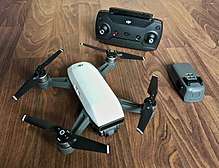
Released in May 2017, the Spark (晓) was designed to be an affordable consumer drone that is nevertheless capable of producing high-quality images and video. It features a 12-megapixel camera capable of shooting 1080p video at 30fps. The camera is stabilised mechanically by a 2-axis gimbal. The Spark also carries an advanced infrared 3D camera that helps the drone to detect obstacles in front of it, as well as facilitating hand-gesture control—a feature that was, until the release of the Mavic Air in January 2018, unique to the Spark. In addition to a smartphone app with virtual controller, a physical controller can also be bought, extending the drone's range up to 1.2 miles (2 km). The aircraft has a flight duration of up to 16 minutes, but its exhausted battery can easily be swapped out for a charged battery to extend flight time.[55]
There have been multiple complaints that the drone could switch off and fall while flying.[56] DJI responded to this by releasing a mandatory battery firmware update in August 2017.[57]
In November 2019 the Mavic Mini was released, replacing the Spark in DJI's consumer line-up.
Camcorders
Osmo
The Osmo (灵眸) is a camcorder developed by DJI. The camera uses a smartphone to view camera footage and can record 4K and take either 12–16 MP stills. The camera is interchangeable, with the Zenmuse X3, X3 Zoom, X5, and X5R gimbals compatible, and uses the FM-15 Flexi microphone.
Osmo Pocket
On 28 November 2018, DJI introduced its newest version of the Osmo when it unveiled the Osmo Pocket. Designed to be small enough to fit into a pocket or purse, the Osmo Pocket is capable of shooting 4K video at 60 frames per second. It also has features such as ActiveTrack, Motionlapse and 3x3 Panorama.[58]
Osmo Action
Announced on 15 May 2019, the Osmo Action is DJI's first product in the action camera market. It is a direct competitor to the GoPro action camera line with specifications including a 12MP camera sensor, 4K video, HDR video, timelapse modes, and a front-facing full-color screen.[59][60][61] The camera also debuted DJI's latest electronic image stabilization technology.[62]
Osmo Action has a CMOS 1/2.3” 12M with a FOV of 145 °F/2.8, an ISO interval for photos between 100-3200 and for video is between 100-3200. The camera is natively waterproof up to 11 meters and can resist to a fall of 1 meters. It can record up to 4K (16:9) at 60 fps and can be charged by internal USB-C port.
Zenmuse gimbal-cameras
Zenmuse series of gimbal cameras are a mixed system made of a compact camera and a 3-axis gimbal, designed as a part of a modular system, for example attached to UAVs. The 2019 Zenmuse X7 gimbal camera features a camera with interchangeable 4 prime DJI DL-mount lenses.
Gimbals and stabilization platforms
Osmo Mobile
Not actually a camcorder, similar to the Osmo, it instead relies on the user's smartphone as the camera. Most smartphones are accepted into the gimbal with a width range of 2.31–3.34 inch (58.6-84.8 mm). The original Osmo Mobile has reached its end-of-life and has been replaced with a second generation.[63]
Osmo Mobile 2
Announced after CES, the DJI Osmo Mobile 2 is the successor to the original Osmo Mobile. Still reliant on a smartphone camera, the Osmo Mobile 2 was a refinement adding multiple shot modes and increasing the battery life to 15 hours. With the rise of Instagram Stories, the Osmo Mobile also allows the gimbal to be placed in portrait mode.[64][65]
Osmo Mobile 3
Announced on August 13, 2019, the Osmo Mobile 3 is the third smartphone stabilizer from the Osmo family of products. The new Osmo Mobile 3 features the return of the front-facing trigger which was missing on the previous generation.[66][67] The big design improvement is the foldable frame which increases portability. Another feature from DJI is the ability of the gimbal to charge smartphones from the integrated battery. It's cheaper than its predecessors and is designed for the social media crowd.[68]
Goggles

The DJI FPV series [69] are head-mounted displays designed for FPV drone flying. There are two different product lines in the FPV series: the DJI Goggles and the Digital FPV System. The DJI Goggles is designed to interface with DJI-branded drones, combining dual LCD display screens, wireless connectivity and direct photo and video capture control into one pair of goggles. In November 2017, DJI also released DJI Goggles RE ("Racing Edition"), which featured a new, more rugged metallic matte black casing and compatibility with racing quadcopters.[70] The DJI Digital FPV System is a standalone system designed for non-DJI brand or custom-built drones, consisting of an action camera, an FPV goggles (which only works with its own camera, not the cameras on other DJI drones), a flight control/signal transmission module and a remote controller.[71]
Educational robots
RoboMaster S1
On 11 June 2019, DJI unveiled the RoboMaster S1 (机甲大师S1), its first consumer ground drone, named after DJI's annual RoboMaster robot combat competition,[72] of which it is now an unofficial mascot. The S1 (meaning "Step 1") is a tank-like rover remotely controlled via Wi-Fi and app on Microsoft Windows, Apple iOS and Google Android mobile devices, with features such as spring-dampened beam axle front suspension, four omnidirectional 12-roller Mecanum wheels that allow agile strafing, a 1080p FVP camera mounted within a 2-axis gimbal turret, and the ability to "fight" other S1 units via either an infrared beam illuminator (which "tags" other objects like in laser tag) or a coaxial gel blaster gun (which shoots hydrogel beads with green LED illumination for tracer effects). Designed to be a mass-produced version of the Infantry robots used in the official competition, the S1 has a total of six sensor panels — four infrared/sound hybrid sensor on four sides of the chassis, and two infrared-only sensor on the lateral sides of the turret), which register hit points for match scoring.
Designed to be an "advanced educational robot", the user has to assemble the S1 from loose parts out of the box and learn to program its AI functionality. Both Scratch and Python are programming languages employed by DJI along with app learning modules to teach the end user how to code.[73]
RoboMaster EP
The DJI RoboMaster EP is the second educational robot from the RoboMaster line, officially released on March 9, 2020, although it was first teased in a YouTube RoboMaster S1 commercial dated on November 25, 2019.[74]
The EP shares similar chassis and Mecanum wheel designs with the S1, is compatible with multi-party hardware, supports multiple software platforms and has an open SDK. The new hardwares include high-performance servos, robotic arms, grippers, infrared depths sensors, sensor transfer, modules and power transfer modules, as well as more than 50 programmable modules. The steering gear of the RoboMaster EP can be customized through a programming interface. The EP supports more than 20 third-party sensors and open-source hardware such as Micro Bit, Arduino and Raspberry Pi.[75]
See also
- List of unmanned aerial vehicles of China
- List of Chinese companies
References
- "Drone-maker DJI to develop more industry applications - Chinadaily.com.cn". Jan 27, 2018. Retrieved Jan 30, 2018.
- "关于大疆:DJI大疆招聘". Retrieved Apr 7, 2020.
- "Company Overview of SZ DJI Technology Co., Ltd". www.bloomberg.com. Retrieved 2018-12-03.
- "10 Things You Probably Didn't Know About DJI". Uplift Drones. June 20, 2018. Archived from the original on June 20, 2018.
- "World's top drone seller made $2.7 billion". January 3, 2018.
- Schmidt, Blake; Vance, Ashlee (25 March 2020). "DJI Won the Drone Wars, and Now It's Paying the Price". www.bloomberg.com. Retrieved 2020-04-03.
- "Drone maker DJI quietly made large chunks of Iraq, Syria no-fly zones". The Register. 2017-04-26. Retrieved 2019-11-12.
- "US Military Still Buying Chinese-Made Drones Despite Spying Concerns". VOA. Retrieved 2019-09-18.
- Schmidt, Blake; Vance, Ashlee (25 March 2020). "DJI Won the Drone Wars, and Now It's Paying the Price". www.bloomberg.com. Retrieved 2020-04-03.
- Colum Murphy and Olivia Geng (November 10, 2014). "Q&A: Chinese Drone Founder Explains Why Steve Jobs Is His Role Model". The Wall Street Journal. Retrieved March 2, 2015.
- "Alumni Kaleidoscope – Frank Wang".
- Mac, Ryan. "Bow To Your Billionaire Drone Overlord: Frank Wang's Quest To Put DJI Robots Into The Sky". Forbes. Retrieved 2020-04-03.
- "Up: A Chinese firm has taken the lead in a promising market". The Economist. 11 April 2015. Retrieved 19 April 2015.
- Ben Popper. "Rise of the RoboMasters".
- Schroth, Frank (31 August 2017). "DJI Wins 2017 Emmy for Technology and Engineering". DRONELIFE.
- "Drone maker Frank Wang becomes Asia's youngest tech billionaire". techwireasia.com.
- "DJI left private keys for SSL, cloud storage in public view and exposed customers".
- "DJI Launches Privacy Mode For Drone Operators To Fly Without Internet Data Transfer". Archived from the original on 2019-09-24. Retrieved 2018-02-02.
- "The Next Frontier of Police Surveillance Is Drones". Slate. 2018-06-07. Retrieved 2019-12-10.
- "These Police Drones are Watching You". Project On Government Oversight. 2018-09-25. Retrieved 2019-12-10.
- Berlinger, Joshua. "Chinese drone maker DJI uncovers fraud that could cost it $150 million". CNN. Retrieved 23 January 2019.
- Horwitz, Josh (22 January 2019). "China drone maker DJI says $150 million scam involved staff padding..." Reuters. Retrieved 23 January 2019.
- "Drone maker DJI bans Washington flights after White House crash". BBC. Retrieved 2018-01-24.
- "FLY SAFEGEO-ZONE MAP". DJI. Archived from the original on 2018-01-24. Retrieved 2018-01-24.
- "Isis use of hobby drones as weapons tests Chinese makers". Financial Times. 2017-12-10. Retrieved 2019-11-12.
- "Pentagon Confronts a New Threat From ISIS: Exploding Drones". New York Times. 2016-10-12. Retrieved 2019-11-12.
- "Waves of Gazans vs. Israeli Tear Gas and Bullets: Deadliest Mayhem in Years". New York Times. 2018-05-14. Retrieved 2019-11-28.
- "First ISIS, then Iraq, now Israel: IDF Use of Commercial Drones". Bellingcat. 2018-06-18. Retrieved 2019-11-28.
- Joe Parkin Daniels (5 August 2018). "Venezuela's Nicolás Maduro survives apparent assassination attempt". The Guardian. Retrieved 5 August 2018.
- "The A2 model". DJI Technology. Retrieved March 2, 2015.
- "DJI Naza-H Helicopter Gyro System w/ GPS". Helipal. Retrieved March 2, 2015.
- "The A2 model". OXM HOFFMAN 360. Retrieved March 2, 2015.
- "DJI Ronin-S". Heliguy. Heliguy. 2018-01-18. Retrieved 2019-08-30.
- "DJI Ronin-SC Announced". Heliguy. Heliguy. 2019-07-17. Retrieved 2019-08-30.
- "Flame Wheel ARF Kit". DJI Technology. Retrieved March 2, 2015.
- "FYFT M5 series blimps". DJI Technology. Retrieved March 2, 2015.
- Personal Tech (September 10, 2014). "An Eye in the Sky, Accessible to the Hobbyist: A Teardown of the Phantom 2 Vision Plus Drone from DJI". The New York Times. Retrieved March 2, 2015.
- "DJI Phantom Released". Retrieved March 2, 2015.
- "2016 DJI Phantom 3 Standard Review | New Lower Price". What Are The Best Drones?. Retrieved 2016-04-19.
- Chase Sutton. "DJI Phantom 2 Vision+ Review and Manual". DroneLifestyle. Retrieved March 2, 2015.
- "DJI Phantom 3 vs Phantom 2 comparison". Drones Den. June 15, 2015. Retrieved June 19, 2015.
- "DJI Phantom 4 RTK". DJI Enterprises. Oct 15, 2018. Archived from the original on December 15, 2018. Retrieved Nov 1, 2018.
- Heater, Brian. "DJI's $799 'smartphone-size' Mavic Air drone starts shipping January 28". TechCrunch. Retrieved 2018-01-23.
- "Is A DJI Mavic Air 2 Without AirSense Worth Buying?". Heliguy. Heliguy. Retrieved 16 June 2020.
- "Spreading-Wings s1000 Plus". DJI Technology. Retrieved March 2, 2015.
- Murison, Malek. "DJI Has Decided That The Inspire 2 is Too Fast". dron life. Retrieved 8 May 2017.
- "DJI Inspire 1 & Inspire 1 Pro Specifications". HoverShotz Aerial Drone Photography, Video and Inspections Cumbria. 2017-01-16. Retrieved 2017-05-16.
- "Drone Best". Archived from the original on 2017-08-31. Retrieved 2017-08-30.
- Matrice 100 release history DJI
- "MATRICE 100: an advanced quadcopter for developers". My Drone Lab. Retrieved 20 March 2018.
- "DJI Matrice 200 Series". Heliguy. Retrieved 12 September 2017.
- "DJI Matrice 210 RTK". Heliguy. Retrieved 12 September 2017.
- "DJI Matrice 200 Series Payload Options". DJI. Archived from the original on 12 September 2017. Retrieved 12 September 2017.
- Kesteloo, Haye (2018-12-27). "DJI Matrice 200 V2, 210 V2 and 210 RTK V2 show in FCC filing". DroneDJ. Retrieved 2018-12-27.
- "DJI Spark is a Selfie Drone for the Masses". News Ledge. 2017-05-24. Retrieved 2017-05-30.
- People are complaining that their new DJI Spark drones are falling out of the sky — Quartz
- "DJI Spark Firmware Update Enhances Flight Safety". DJI Official. Archived from the original on 2019-12-28. Retrieved 2017-09-30.
- "DJI Osmo Pocket – 3-Axis Stabilized Handheld Camera – DJI". DJI Official. Archived from the original on 2019-07-01. Retrieved 2018-11-28.
- "Osmo Action – Unleash Your Other Side – DJI". DJI Official. Archived from the original on 2019-08-11. Retrieved 2019-05-16.
- Goldman, Joshua. "DJI Osmo Action cam has two big features your GoPro doesn't". CNET. Retrieved 2019-05-16.
- Chavers·GearPhotography·May 16, Marcus; 2019 (2019-05-16). "How Does the DJI Osmo Action Stack Up Against the GoPro Hero7?". News Ledge. Retrieved 2019-05-16.CS1 maint: numeric names: authors list (link)
- DJI (2019-05-15), DJI - Introducing Osmo Action, retrieved 2019-05-16
- "Osmo Mobile Specs". DJI. Archived from the original on 2016-09-10.
- "DJI Osmo Mobile 2 – Smartphone Gimbal – DJI". DJI Official. Archived from the original on 2019-07-24. Retrieved 2018-09-10.
- "Shutter Release: How to Choose the Best Vlogging Cameras of 2018". News Ledge. 2017-06-08. Retrieved 2018-09-10.
- Chavers·GearPhotography·August 13, Marcus; 2019 (2019-08-13). "DJI Osmo Mobile 3 Goes For Quality of Life With Caveats". News Ledge. Retrieved 2019-08-16.CS1 maint: numeric names: authors list (link)
- "Osmo Mobile 3 - Foldable Mobile Gimbal-DJI". DJI Official. Archived from the original on 2019-12-26. Retrieved 2019-08-16.
- "Osmo Mobile 3 - Foldable Mobile Gimbal-DJI". DJI Official. Archived from the original on 2019-12-26. Retrieved 2019-08-16.
- "DJI Goggles". DJI. Archived from the original on 2017-04-27.
- "DJI Racing Edition Goggles". Drone Addicts.
- "DJI Digital FPV System". Archived from the original on 2019-12-19. Retrieved 2019-10-16.
- "The RoboMaster S1 – Intelligent Educational Robot – DJI". DJI Official. Archived from the original on 2019-09-28. Retrieved 2019-06-23.
- O'Kane, Sean (2019-06-11). "DJI's newest drone is a $499 tank meant to teach kids how to code". The Verge. Retrieved 2019-06-23.
- DJI (2019-11-25). DJI RoboMaster S1 - Creativity is a Gift. YouTube. Retrieved 2020-03-10.
- Kesteloo, Haye (2020-03-09). "DJI releases RoboMaster EP on March 9th as predicted". DroneDJ. Retrieved 2020-03-10.
External links
